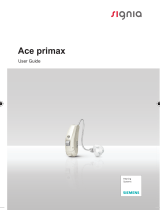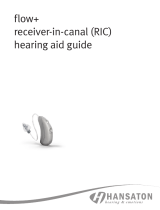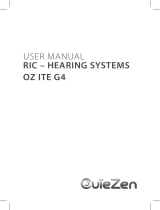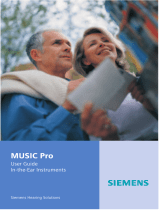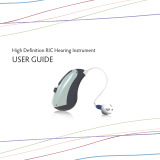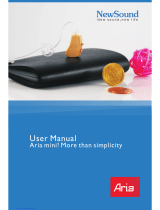Page is loading ...

resound.com
User guide
Behind-The-Ear hearing aids
400146011-US-16.11-Rev.J.indd 1 15-12-2016 10:37:50

2
Hearing instrument type designations for models included in this user guide are: SY312, FCC ID: X26SY312,
IC: 6941C-SY312; SY312e, FCC ID: X26SY312e, IC: 6941C-SY312e; and MRIE, FCC ID: X26MRIE, IC:
6941C-MRIE. FCC ID: X26VE312; VE312, IC: 6941C-VE312. Please see page 6 for list of models referring
to all types.
Statement:
This device complies with part 15 of the FCC rules and ICES-003 of the IC rules.
Operation is subject to the following two conditions: (1) this device may not cause harmful inter ference,
and (2) this device must accept any interference received, including interference that may cause undesired
operation.
Note: This equipment has been tested and found to comply with the limits for a Class B digital device,
pursuant to part 15 of the FCC Rules and ICES-003 of the IC rules. These limits are designed to provide
reasonable protection against harmful interference in a residential installation. This equipment generates,
uses and can radiate radio frequency energy and, if not installed and used in accordance with the instruc-
tions, may cause harmful interference to radio communications.
400146011-US-16.11-Rev.J.indd 2 15-12-2016 10:37:50

3
However, there is no guarantee that interference will not occur in a particular installation. If this equipment
does cause harmful interference to radio or television reception, which can be determined by turning the
equipment off and on, the user is encouraged to try to correct the interference by one or more of the fol-
lowing measures:
• Reorient or relocate the receiving antenna.
• Increase the separation between the equipment and receiver.
• Connect the equipment into an outlet on a circuit different from the one in which the receiver is con-
nected.
• Consult the dealer or an experienced radio/TV technician for help.
Changes or modifications can void the user´s authority to operate the equipment.
Intended use
Generic air-conduction hearing instruments are wearable sound-amplifying devices intended to compen-
sate for impaired hearing. The fundamental operating principle of hearing instruments is to receive, amplify,
and transfer sound to the ear drum of a hearing impaired person.
List of countries:
Products without wireless functionality are intended for worldwide sales.
400146011-US-16.11-Rev.J.indd 3 15-12-2016 10:37:50

4
The products are in compliance with the following regulatory requirements:
• In US: FCC CFR 47 Part 15, subpart C.
• Other identified applicable international regulatory requirements in countries outside US. Please refer to
local country requirements for these areas.
• In Canada: these hearing instruments are certified under the rules of IC.
• Cet appareil numérique de la classe B est conforme à la norme NMB-003 du Canada.
• Japanese Radio Law and Japanese Telecommunications Business Law Compliance. This device is
granted pursuant to the Japanese Radio Law (電波法) and the Japanese telecommunications Business
Law (電気通信事業法) This device should not be modified (otherwise the granted designation number
will become invalid)
• Patents
US 7,593,537 US 8,00,849
400146011-US-16.11-Rev.J.indd 4 15-12-2016 10:37:50

5
ReSound is a registred trade mark of ReSound A/S
Introduction
Congratulations on the purchase of your new hearing instruments. ReSound’s innovative sound technology
and design, combined with the customized device programming selected by your hearing care profes-
sional, will make hearing a more enjoyable experience. Hearing instruments will enable you to hear sounds
that you may not have heard in years because of your hearing loss. Practice and a positive attitude are
important in learning to use hearing instruments. Your ReSound instruments have been adjusted according
to your individual hearing loss and needs. Some people adjust quickly to wearing hearing instruments in
their ears and hearing new sounds; other people may need more time.
Please read this manual carefully in order to wholly benefit from the use of your hearing instruments. With
proper care, maintenance, and usage, your hearing instruments will aid you in better communication for
many years. Ask your hearing care professional if you have any questions.
400146011-US-16.11-Rev.J.indd 5 15-12-2016 10:37:50

6
Hearing instrument model:
Model 60: Battery size 10
Model 61: Battery size 312
Model 62: Battery size 312
Receiver tube length:
Dome size:
Left serial number:
Right serial number:
400146011-US-16.11-Rev.J.indd 6 15-12-2016 10:37:50

7
Micro receiver-in-the-ear (RIE) hearing in-
struments with size 10A battery are available in
the following variants:
AL960-DR, AL760-DR, AL560-DR ALT960-DR
VO960-DR, VO760-DR, VO560-DR, VOT960-DR,
VOT760-DR
Mini receiver-in-the-ear (RIE) hearing instru-
ments of type SY312 with FCC ID X26SY312, IC
number 6941C-SY312 and
size 312 battery are available in the
following variants:
AL961-DRW, AL761-DRW AL561-DRW, AL461-
DRW ALT961-DRW
Mini receiver-in-the-ear (RIE) hearing instru-
ments of type SY312e with FCC ID X26SY312e,
IC number 6941C-SY312e and size 312 battery
are available in the following variants:
VO961-DRW, VO761-DRW, VO561-DRW, VOT961-
DRW, VOT761-DRW
Mini Receiver In-the-Ear (RIE) hearing
instruments of type VE312 with FCC ID:
X26VE312, IC number 6941C-VE312 and size
312 battery are available in the following
variants:
LN961-DRW, LN761-DRW, LN561-DRW, LNT961-
DRW, LNT761-DRW
Receiver-in-the-ear (RIE) hearing instruments
of type MRIE with FCC ID X26MRIE, IC number
6941C-MRIE and size 312 battery are available
in the following variants:
AL962-DVIRW, AL762-DVIRW AL562-DVIRW,
AL462-DVIRW ALT962-DVIRW, ALT762-DVIRW
VO962-DRW, VO762-DRW, VO562-DRW,
VOT962-DRW, VOT762-DRW
The identification number for the MRIE, SY312,
SY312e, and VE312 device models can be found at
location “15” as indicated in the illustrations on page 9.
400146011-US-16.11-Rev.J.indd 7 15-12-2016 10:37:51

8
Contents
Introduction...............................5
Getting started ...........................12
On/Off function ...........................12
SmartStart ..............................12
Inserting/Replacing the battery...............12
Low battery indicator ......................13
Sports lock ..............................14
Inserting/Removing hearing instruments........14
Program and Multi-Function buttons ..........16
Flight mode* (Wireless models only) . . . . . . . . . . . 19
Telephone use............................21
Listen to radio or TV .......................22
Using ReSound Hearing Instruments with iPhone
®
,
iPad
®
, and iPod touch
®
(ReSound LiNX) ........22
Cellular phones...........................22
PhoneNow ..............................23
Telecoil (optional)..........................25
Tele-loop systems.........................26
Direct audio input (optional) .................26
Connecting/Disconnecting audio boots ........26
Care and maintenance .....................27
Daily maintenance.........................28
The receiver tube .........................29
Cleaning the receiver tubes and domes ........29
Cleaning RIE or molds .....................29
Changing wax guard for receiver tube .........30
How to apply domes.......................31
Using ReSound hearing instruments with smart
phone apps..............................33
General precautions .......................34
General warnings .........................35
Tinnitus Sound Generator (TSG) module .......36
TSG warnings ............................37
User instructions for the TSG module ..........37
TSG precautions..........................39
The scientific concepts that form
the basis for the device .....................40
Significant physical characteristics ............40
Prescription use of this TSG hearing instrument ..41
400146011-US-16.11-Rev.J.indd 8 15-12-2016 10:37:51

9
Important notice for prospective
sound generator users .....................41
TSG warning to hearing healthcare professionals 42
Battery warning information .................43
Hearing instrument expectations .............43
Warning to hearing aid dispensers (US Only) ....44
Important notice for prospective
hearing aid users (US Only)..................44
Children with hearing loss (US Only) ..........45
Troubleshooting Guide .....................46
Technical data............................50
Warranty and repairs ......................64
Temperature test, transport and
storage information ........................64
400146011-US-16.11-Rev.J.indd 9 15-12-2016 10:37:51

7
1
8
2
7
9
1
8
2
3
6
54
10
60 models
61 models
(type SY312e and
SY312)
1. Receiver tube
2. Receiver Open Dome
3. Receiver Tulip Dome
4. Receiver Power Dome
5. RIE mold
6. Sports lock
7. Battery compartment
8. Receiver
9. Push button
10. Volume Control (optional)
11. S receiver tube
12. NP receiver tube
13. HP receiver tube
14. Left/right indicator
15. Model, and serial number
16. Direct audio input
17. UP Receiver/Mold
400146011-US-16.11-Rev.J.indd 10 15-12-2016 10:38:03

7
9
1
8
2
15
14
9, 10
1
8
2
15
16
14
7
13 1711 12
11
62 models
(type MRIE)
(Indentification number for the SY312e
and SY312 devices)
ReSound LiNX
TM
device
400146011-US-16.11-Rev.J.indd 11 15-12-2016 10:38:16

2
1
3
12
Getting started
On/Off function
1. When the battery door is closed, the hearing instrument turns on,
and the default program will be activ ated.
2. To turn off the hearing instrument, open the battery door. Use your
fingernail to pull it open.
SmartStart
Hearing instruments can be turned on once you have placed them on your ears. If you prefer to turn them on
just prior to placing them on your ear, your hearing care professional can activate a function called Smart-
Start. This function will delay the time in which the hearing instruments turn on after the battery compart-
ment is closed. With SmartStart, a beep will be heard for each second of the delay period.
Inserting/Replacing the battery
1. Open the battery door completely by using your fingernail. Remove the used battery if present.
2. Prepare the new battery (please refer to page 7 for information on appropriate battery type/size for your
hearing instrument). Remove the protective foil and wait 2 minutes before inserting the battery into the
hearing instrument to allow activation of the battery.
3. Insert the new battery with the positive side in the correct position.
4. Gently close the battery door.
On
Off
400146011-US-16.11-Rev.J.indd 12 15-12-2016 10:38:23

13
i
Tip:
1. Always use new Zinc-Air batteries that have a minimum remaining shelf life of one year.
2. Whenever the hearing instruments are not in use, remember to turn them off to avoid unnecessary
battery consumption.
Low battery indicator
Your hearing care professional can set your hearing instrument to give an acoustical indication when the bat-
tery is reaching its end of life. The hearing instrument will reduce amplification and emit a melody if battery
power gets too low. This signal will recur every five minutes (every 15 minutes for the LiNX models) until the
hearing instrument automatically switches off. It is recommended that you keep spare batteries on hand.
Low battery indicator (instruments paired with accessories only)
Active usage of the ReSound Unite accessories (Remote Control, Phone Clip, TV Streamer and Mini Micro-
phone) requires more battery power from the hearing instruments than when these are working on their own
meaning that battery life is highly dependent on the amount of wireless accessory usage. When the battery
in the hearing instrument has depleted to a level at which use of the ReSound Unite TV Streamer, Phone
Clip and Mini Microphone cannot be supported, the hearing instrument will play two sets of descending
tones. After this, your hearing instrument and ReSound Unite Remote Control will continue to work as usual,
but you will not be able to use your ReSound Unite TV Streamer, Phone Clip and Mini Microphone. At some
point the battery level will not support the remote control either and you will once again hear the descending
tones. The hearing instruments will continue to work as usual. Once a new battery is inserted, full operation
of the accessories will resume.
400146011-US-16.11-Rev.J.indd 13 15-12-2016 10:38:23

14
Sports lock
The sports lock will be applied or adjusted by your hearing care professional.
Inserting/Removing hearing instruments
Insertion (custom RIE and UP molds)
1. Hold the RIE mold between your thumb and index finger and position its sound
outlet in your ear canal.
2. Slide the RIE mold all the way into your ear with a gentle, twisting movement.
3. Move the RIE mold up and down and gently press to ensure it is positioned correctly
in the ear. Opening and closing your mouth can ease insertion.
4. Make sure the hearing instrument is seated behind the ear.
By experimenting, an easier method may be discovered. With proper insertion, hearing
instruments should fit snugly but comfortably. If hearing instruments cause irritation of
the ears, contact your hearing care professional.
i Never attempt to modify the shape of the hearing instrument, RIE molds, or tubing yourself.
i
Tip: It may be helpful to pull the top of your ear back with your opposite hand during insertion to open
the ear canal.
400146011-US-16.11-Rev.J.indd 14 15-12-2016 10:38:30

15
Insertion (domes)
1. Hold the receiver tube where it bends, and
gently place the dome into the ear canal.
Push the dome far enough into the ear canal
so that the receiver tube lies flush with the
side of the head.
2. It is important that the tube and the dome fit
correctly into your ear.
3. When the dome is placed correctly, you should not be able to see the receiver tube sticking out when
facing a mirror.
i Note: You should never attempt to bend or modify the shape of the receiver tube.
Removal (RIE mold)
1. Grasp the removal string and pull the RIE or UP mold outward.
2. Consult your hearing care professional if you have difficulties removing the hearing instrument.
Removal (domes)
1. Hold the receiver tube with your thumb and forefinger and remove the tube.
2. Consult your hearing care professional if you have difficulties removing the
hearing instrument.
400146011-US-16.11-Rev.J.indd 15 15-12-2016 10:38:37

16
Program and Multi-Function buttons
If you have a hearing aid with a program button or multi-function button, this will allow you to use up to four
different listening programs, each of them suitable for certain situations.
Program button (61 models only) Multi-function button (62 models only)
Your hearing care professional can fill out the following table for you.
Program Description of when to use
1
2
3
4
400146011-US-16.11-Rev.J.indd 16 15-12-2016 10:38:41

17
When using the program or multi-function buttons to switch programs, each press will move the instrument
to the next program. For example, if it was in program 1 it will switch to program 2, if it was in program 2 it
will switch to program 3 etc.
When you close the battery door and switch the instrument on, it will start in program 1. Press the program
or multi-function buttons if you want to move to a different listening program.
If you have two hearing instruments with the synchronization function enabled, program changes to one
instrument will automatically repeat in the second instrument. When a program change is made in one
instrument, you will hear the same amount of confirmation beeps in the second instrument.
Your instrument has a fully automatic volume control. Therefore, it should not be necessary to control the
volume manually.
However, in addition to controlling listening programs, the multi-function button (62 models only) provides
you with the ability to adjust the amplification to your liking.
400146011-US-16.11-Rev.J.indd 17 15-12-2016 10:38:41

18
If you have two hearing instruments with the synchronization function enabled and you have the Multifunc-
tion Button set for volume control functionality, volume adjustments to one instrument will automatically
repeat in the second instrument. When a volume control adjustment is made in one instrument, you will hear
a confirmation beep. A beep in the second instrument will follow.
The multi-function button is designed to change the volume or listening programs of the hearing instrument,
based on different ways it is pressed.
If necessary, your hearing care practitioner can change these settings and fill in the following table to indi-
cate the new settings:
Multi-function button action Default setting New setting
Short press up Increases volume
Short press down Decreases volume
Long press up (3 seconds) Changes programs
Long press down (3 seconds Activates streaming
400146011-US-16.11-Rev.J.indd 18 15-12-2016 10:38:41

19
i Flight mode* (Wireless models only)
When boarding a flight or entering an area where RF transmitters are prohibited, wireless functionality must
be deactivated, as it is not allowed to radiate radio signals during flights or in otherwise restricted areas.
For Alera wireless hearing instruments follow the following steps to enter and leave flight mode:
It is possible to disable wireless operation by opening and closing the battery compartment of the hearing
instrument while at the same time pressing the push button.
When disabled manually, wireless operation may be re-enabled by opening and closing the battery com-
partment normally, (i.e. without at the same time pressing the push button).
For all other wireless hearing instruments follow the following steps to enter and leave flight
mode: It is possible to disable wireless operation by opening and closing the battery compartment three
times within a ten second period (open-close, open-close, open-close). Your instruments will now be in
flight mode.
*For wireless models only
400146011-US-16.11-Rev.J.indd 19 15-12-2016 10:38:41

20
If the hearing instrument is in flight mode, the hearing instrument must have been operating in flight mode
for at least 10 seconds before attempting to enable wireless again. it is possible to re-enable wireless opera-
tion by opening and closing the battery door once. 10 seconds after this operation is completed, wireless
operation will begin again.
i
Note: It is important to wait an additional 15 seconds after wireless function resumes before open-
ing and closing the battery compartment again for any reason. If the battery compartment is opened and
closed during this 15 second window, flight mode will resume.
*For wireless models only
400146011-US-16.11-Rev.J.indd 20 15-12-2016 10:38:41
/
